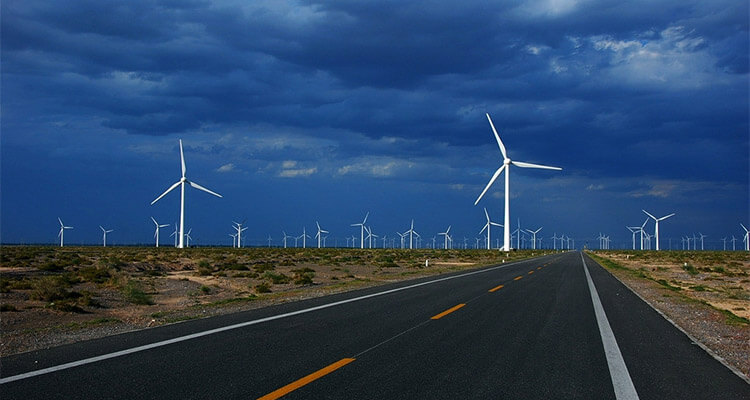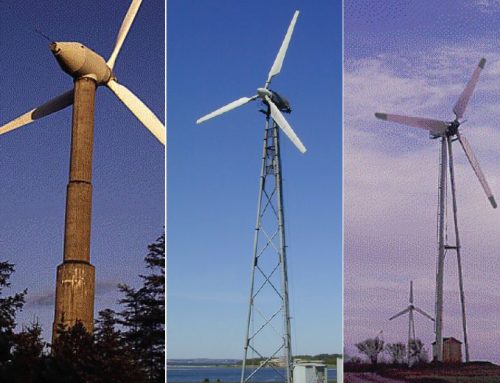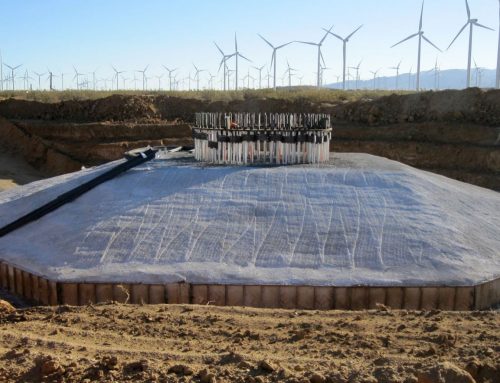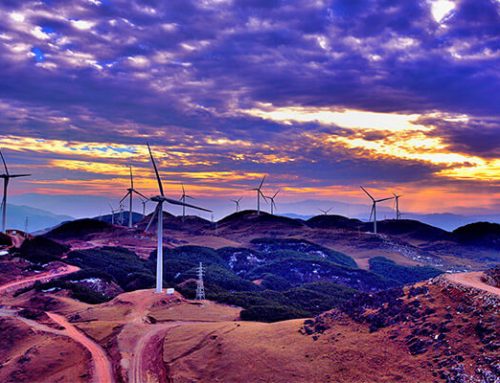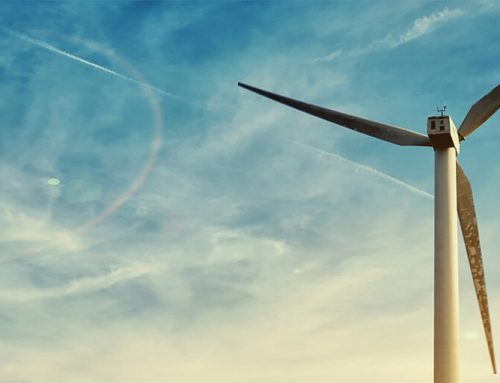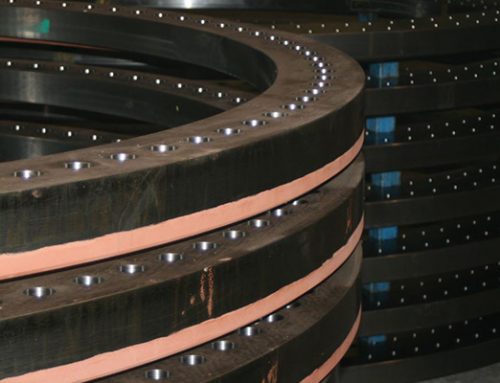Wind tower foundation is the base component of wind turbine towers. Wind Tower Foundations not only bear the complete weight of hundred meters high wind tower and the upper wind turbine, but also host all the stress states under wind turbine vibration, and the extreme weathers like: earthquake, strong wind, etc. The stiffness of wind tower foundations is the key element of the safety and stability of wind turbine system operation. In other word, the life or death problem of the complete wind turbine system depends on the stiffness of wind tower foundations.
Right now, on the wind tower construction market, there are different types of wind tower foundation construction methods. Each of the wind tower foundation construction method has its unique construction scales and features. In the following content, we will discuss the features, applications, limits of different types of wind tower foundations.
Onshore Wind Tower Foundations
There are six types of onshore wind tower foundations which has been utilized in global onshore wind tower construction projects.
Gravity Spreading Foundation of Onshore Wind Tower
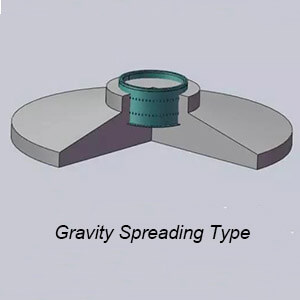 After the development of gravity spreading onshore wind tower foundation, it is widely applied to many different onshore wind farm projects.
After the development of gravity spreading onshore wind tower foundation, it is widely applied to many different onshore wind farm projects.
For gravity spreading onshore wind tower foundation, the wind tower and the wind tower foundation part is connected through wind tower anchor cage. Wind tower anchor cage is consist of an anchor plate, a load distribution plate, and several anchor bolts. There are many holes on the anchor plate and load distribution plate, so the anchor bolts can connect two plates together. After the assemble of wind tower anchor cage, concrete will be pouring around the anchor cage, so that the stiffness of wind tower foundation is increased.
Gravity Spreading Foundation Suitable Terrain
Gravity spreading onshore wind tower foundation can be applied to all the different landforms, such as flatland, hilly area, plateau, etc.
Gravity Spreading Onshore Wind Tower Foundation Limits
For gravity spreading onshore wind tower foundations, the connection part of wind tower anchor cage and concrete base part may suffers stiffness mutation problem. Under the long term influence of alternating load, the concrete part around wind tower anchor cage will be under the risks of fatigue fracture. Therefore, during the wind tower foundation design process, the fatigue fracture problem must be paid special attentions.
Gravity Foundation of Onshore Wind Tower
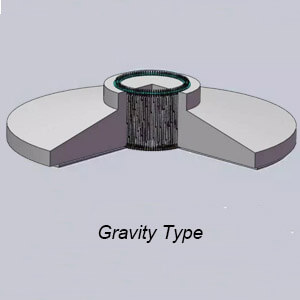 In actual wind farm project construction process, onshore wind tower gravity foundation and wind tower section is connected via anchor bolts. After the installation of steel wind tower sections, the anchor bolts must be applying certain pretension based on wind tower foundation design for different wind farm projects, so that the wind tower is firmly connected with the gravity foundation of onshore wind tower. Moreover, among the anchor bolts of wind tower anchor cage, there will be steel bars connect different anchor bolts together, and an anchor plate setting under the complete anchor cage. Last but not least, concrete will be pouring in the anchor cage and steel bar net to solidify the wind tower foundation part. Onshore wind tower gravity foundation doesn’t have the problem of stiffness mutation. The bearing condition of onshore wind tower gravity foundation is well-proportioned, it has good integrality.
In actual wind farm project construction process, onshore wind tower gravity foundation and wind tower section is connected via anchor bolts. After the installation of steel wind tower sections, the anchor bolts must be applying certain pretension based on wind tower foundation design for different wind farm projects, so that the wind tower is firmly connected with the gravity foundation of onshore wind tower. Moreover, among the anchor bolts of wind tower anchor cage, there will be steel bars connect different anchor bolts together, and an anchor plate setting under the complete anchor cage. Last but not least, concrete will be pouring in the anchor cage and steel bar net to solidify the wind tower foundation part. Onshore wind tower gravity foundation doesn’t have the problem of stiffness mutation. The bearing condition of onshore wind tower gravity foundation is well-proportioned, it has good integrality.
Gravity Foundation Suitable Terrain
Same as Gravity spreading onshore wind tower foundation, wind tower gravity foundation can be applied to all the different landforms, such as flatland, hilly area, plateau, etc.
Gravity Onshore Wind Tower Foundation Limits
Onshore wind tower gravity foundation requires high quality anchor bolts. The tension and corrosion resistance performance of anchor bolts must be specially designed.
Rock Foundation of Onshore Wind Tower
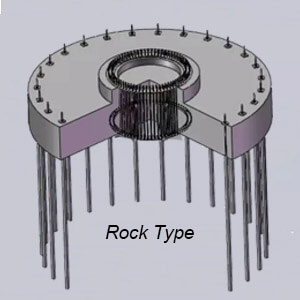 Same as wind tower gravity foundation, the connection between wind tower anchor cage and wind tower is through anchor bolts. But the anchor cage is reinforced in the rocks through anchor rod, use the bearing capacity of rocks to fix the wind tower foundation part. Wind tower rock foundation has significantly reduced the concrete and steel bar work amount. In other word, it reduce the basic cost of wind farms.
Same as wind tower gravity foundation, the connection between wind tower anchor cage and wind tower is through anchor bolts. But the anchor cage is reinforced in the rocks through anchor rod, use the bearing capacity of rocks to fix the wind tower foundation part. Wind tower rock foundation has significantly reduced the concrete and steel bar work amount. In other word, it reduce the basic cost of wind farms.
Rock Foundation Suitable Terrain
Unlike onshore wind tower gravity foundations, wind tower rock foundation is specially designed for wind farms that are built on rock ground, like mountains, hilly areas, etc.
Rock Onshore Wind Tower Foundation Limits
Onshore wind tower rock foundation has strict quality requirements for anchor bolts and anchor rods. The corrosion resistance of anchor rods must be specially designed. As it requires strong bearing strength of the ground, the applicability of wind tower rock foundation is limited.
Fatigue Reistant Foundation of Onshore Wind Tower
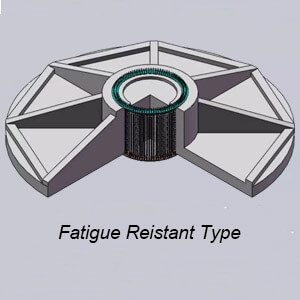 Like all the other onshore wind tower foundations, fatigue reistant foundation anchor cage connects wind tower sections through anchor bolts. The most obvious feature of wind tower fatigue reistant foundation is the reinforced structure around anchor cage uses beams and slabs. Therefore, fatigue reistant foundation also saves the work amount of concrete.
Like all the other onshore wind tower foundations, fatigue reistant foundation anchor cage connects wind tower sections through anchor bolts. The most obvious feature of wind tower fatigue reistant foundation is the reinforced structure around anchor cage uses beams and slabs. Therefore, fatigue reistant foundation also saves the work amount of concrete.
Fatigue Reistant Foundation Suitable Terrain
Fatigue reistant foundation of onshore wind tower can be applied to all the different landforms, such as flatland, hilly area, plateau, etc.
Fatigue Reistant Onshore Wind Tower Foundation Limits
Onshre wind tower fatigue reistant foundation needs large amount of steel bars, and large quantity of template construction work. The distance between steel bars are small, so it is not easy to vibrate the concrete densely.
